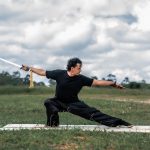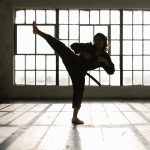Mixed Martial Arts (MMA), a dynamic combat sport, offers fighters a captivating dance of technique and strategy. Within this realm, various stances serve as the foundation for fighters' movements and attacks.
From the orthodox and southpaw stances to the fusion of the switch stance, each offers unique advantages and benefits.
This article explores the features and benefits of different MMA stances, delving into the nuances of boxing, muay Thai, karate, and more.
Prepare to deepen your mastery of MMA with a comprehensive understanding of its varied stances.
Key Takeaways
- MMA fighters can choose between orthodox and southpaw stances, or utilize a switch stance that combines both.
- The Muay Thai stance is effective against opponents who focus on boxing and those looking to close the distance.
- The boxing stance allows for excellent footwork, head and body movement, forward pressure, and power in punches.
- Karate stances emphasize mobility, quick movements, and explosive techniques, making them effective for quick strikes and evasive maneuvers.
Orthodox Stance
Characterized by a dominant lead hand and rear hand, the Orthodox Stance is a fundamental position in MMA that offers fighters a strong foundation for striking and defense.
In this stance, the lead hand is positioned slightly forward, with the rear hand closer to the chin for protection.
The benefits of the orthodox stance are numerous. Firstly, it allows for effective striking, as the lead hand can be used to set up jabs and hooks, while the rear hand provides power for crosses and uppercuts.
Secondly, the orthodox stance provides good balance and stability, enabling fighters to move quickly and efficiently. Additionally, this stance offers solid defense, with the lead shoulder providing cover and the rear hand ready to block or counter.
Techniques such as the jab, cross, hook, and uppercut are commonly used in the orthodox stance, making it a versatile and effective position for MMA fighters.
Southpaw Stance
Interestingly, the Southpaw Stance is a unique and advantageous position in MMA that offers fighters a strategic edge over their orthodox opponents.
In this stance, the fighter's right hand and right foot are forward, with the left side of the body facing the opponent.
The advantages of the southpaw stance include an element of surprise, as it is less common than the orthodox stance, making it difficult for opponents to anticipate strikes and movements.
Additionally, the southpaw stance allows for better positioning for certain techniques, such as a strong left cross and left hook, which can catch opponents off guard.
Fighters in the southpaw stance can also effectively target an orthodox opponent's liver with their left hand.
However, it is important for fighters to be aware of their vulnerabilities in this stance, such as being susceptible to right-handed attacks from their opponents.
Switch Stance
Occasionally utilized by skilled MMA fighters, the switch stance involves seamlessly transitioning between orthodox and southpaw positions during a fight. This technique provides several pros and cons for fighters.
The switch stance offers unpredictability and confusion to opponents, as it allows fighters to change their lead hand and foot quickly. This can make it difficult for opponents to anticipate strikes and counter effectively. Additionally, the switch stance enables fighters to access different angles and create openings for attacks.
However, the switch stance also has its drawbacks. Switching stances requires precision, timing, and balance, which can be challenging to execute in the heat of a fight. It also leaves fighters momentarily vulnerable to attacks during the transition.
To effectively utilize the switch stance, fighters must practice footwork drills and develop a strong sense of timing and distance. They can incorporate techniques such as switching their stance while throwing strikes, using feints to set up switches, or seamlessly transitioning between orthodox and southpaw positions during combinations.
Mastery of the switch stance can add another layer of versatility to a fighter's arsenal.
Muay Thai Stance
The Muay Thai stance, with its loose and light positioning on the front leg and a high guard, enhances a fighter's defensive capabilities while providing an effective base for powerful strikes. This stance is widely used in MMA for its numerous benefits.
One of the main advantages of the Muay Thai stance in MMA is its defensive capabilities. The high guard protects the fighter's head and face from strikes, while the loose positioning on the front leg allows for quick evasion and movement. Additionally, the narrow stance and square hips facing forward enable fighters to effectively defend against opponents who are boxing-heavy or looking to close the distance.
In terms of striking, the Muay Thai stance provides a solid base for powerful strikes. The even weight distribution allows for quick weight shifts, enabling fighters to generate maximum power in their punches, kicks, and knees. The toes facing forward also facilitate powerful kicks and knees.
Techniques and strategies for the Muay Thai stance in MMA include utilizing the high guard to block and parry strikes, using quick footwork to maintain distance and evade opponents, and capitalizing on the narrow stance to deliver devastating kicks and knees. Fighters in the Muay Thai stance should also be well-versed in clinch work, as it is a prominent aspect of Muay Thai and can be effectively incorporated into MMA.
Table:
| Benefits of Muay Thai Stance in MMA | Techniques and Strategies for Muay Thai Stance in MMA |
|---|---|
| Enhanced defensive capabilities | Utilize high guard for blocking and parrying strikes |
| Effective base for powerful strikes | Utilize quick footwork for distance management and evasion |
| Solid balance and weight shifts | Utilize narrow stance for devastating kicks and knees |
| Effective against boxing-heavy opponents and those looking to close the distance | Incorporate clinch work for grappling and controlling opponents |
Boxing Stance
The boxing stance is a fundamental stance in MMA that emphasizes footwork, head movement, and power in punches. It is a bladed and shoulder-width stance, reducing the target area and making it harder for opponents to land strikes.
In the boxing stance, fighters are flat-footed to generate power in their punches, but they can also be light on the balls of their feet for quick movements. The weight distribution can be heavier on the lead leg for more power or evenly distributed for defensive footwork.
The high guard with gloves around the forehead and elbows tucked in provides excellent protection. The advantages of the boxing stance include great footwork, head and body movement, forward pressure, and the ability to generate power in punches. It also allows fighters to effectively counter and evade attacks.
In contrast, the muay Thai stance focuses more on defensive strategies, such as utilizing a high guard and narrow stance to defend against opponents who are boxing-heavy or looking to close the distance.
Karate Stance
Karate stances, characterized by their emphasis on mobility and quick movements, play a crucial role in the arsenal of techniques utilized by MMA fighters. These stances offer a range of benefits that can greatly enhance an MMA fighter's performance.
One of the main advantages of the karate stance is its ability to facilitate effective strikes. Karate practitioners are trained to generate power and speed in their punches and kicks, allowing them to deliver devastating blows to their opponents.
Additionally, the mobility of the karate stance allows fighters to swiftly move in and out of range, making it easier to evade attacks and launch counter-attacks. The quick movements and explosive techniques associated with karate stances make them a valuable asset for MMA fighters looking to dominate their opponents in the cage.
MMA Stance
Utilizing a blend of various martial arts stances and techniques, the MMA stance allows fighters to adapt and showcase their versatility in different combat scenarios. In MMA, fighters have the freedom to switch between different stances or blend elements from various martial arts to create their unique style.
The importance of footwork cannot be overstated in MMA stances. Proper footwork allows fighters to maintain balance, move quickly, and generate power in their strikes. Different MMA stances are employed depending on the situation.
For example, the Muay Thai stance is effective against opponents who rely heavily on boxing or are looking to close the distance. The boxing stance provides excellent footwork, head movement, and power in punches. Karate stances focus on mobility and quick movements, allowing for quick strikes and evasive maneuvers.
The MMA stance combines the best elements from these stances to create a versatile approach to combat, incorporating striking, grappling, and takedown defense.
Versatility in MMA Stances
Moreover, MMA stances offer a remarkable versatility and adaptability in combat situations, allowing fighters to seamlessly transition between different techniques and strategies. One aspect of this versatility is the advantages of a switch stance.
A switch stance refers to a fighter being able to switch between orthodox and southpaw positions during a fight. This allows the fighter to confuse their opponent, create different angles of attack, and exploit weaknesses in their opponent's defense.
Additionally, footwork plays a crucial role in MMA. The importance of footwork in MMA cannot be overstated, as it enables fighters to maintain balance, move efficiently, and generate power in their strikes.
By incorporating proper footwork techniques, fighters can effectively control the distance, change angles, and evade their opponent's attacks.
This versatility in stances and the emphasis on footwork make MMA a dynamic and strategic combat sport.
Benefits of Different MMA Stances
When properly executed, fighters can experience increased stability and improved offensive and defensive capabilities by adopting and transitioning between different MMA stances.
The benefits of different MMA stances include:
- Enhanced balance and stability: Different stances allow fighters to distribute their weight effectively, providing a solid base for strikes, takedowns, and defensive maneuvers. This stability enables fighters to generate more power in their attacks and maintain control during grappling exchanges.
- Improved footwork: Footwork plays a crucial role in MMA, and different stances offer unique advantages in terms of movement and positioning. Whether it's the nimble footwork of the boxing stance or the explosive movements of the karate stance, fighters can utilize footwork to create angles, evade attacks, and launch counterattacks.
- Strategic versatility: By adopting different stances, fighters can adapt their style of fighting to exploit their opponent's weaknesses. Switching between stances can confuse opponents, making it harder for them to anticipate strikes or takedowns. This strategic versatility allows fighters to dictate the pace and flow of the fight, giving them a significant advantage in the cage.
Conclusion
In conclusion, the different stances in MMA provide fighters with versatility and adaptability in combat situations. The orthodox and southpaw stances are the primary stances used, with some fighters incorporating a switch stance. Each martial art within MMA brings its own unique stance and benefits, such as the loose and light front leg in muay Thai or the bladed position and effective footwork in boxing.
Overall, the variety of stances allows fighters to incorporate striking, grappling, and takedown defense techniques, enhancing their overall performance in the sport.
Interesting statistic: Studies have shown that approximately 70% of successful strikes in MMA fights are delivered from an orthodox stance, highlighting its effectiveness and widespread usage among fighters.
- 15 Best Martial Arts Weapons (Fighting & Training) - October 14, 2024
- Is Fencing a Martial Art? (Yes, 4 Reasons Why) - October 14, 2024
- 7 Best Martial Arts for Self-defense Ranked (Highly Effective) - October 14, 2024










